Fiber Lasers Based on Dynamic Population Gratings in Rare-Earth-Doped Optical Fibers
Abstract
1. Introduction
2. Theoretical Part
3. Lasers with Generation of Stabilized SLM Radiation
3.1. Approaches for the Gain DPG Suppression
3.2. Approaches for Effective Formation of the Absorption DPG
3.3. Summary
4. Fiber Lasers with Wavelength Self-Sweeping
4.1. Approaches for the Effective Formation of Gain DPG in WLSS Lasers
4.2. Approaches for the Mode Dynamics Control
4.3. Approaches for the WLSS Range Control
4.4. Summary
5. Applications of Lasers Based on DPGs
6. Conclusions
Author Contributions
Funding
Institutional Review Board Statement
Informed Consent Statement
Data Availability Statement
Conflicts of Interest
References
- Kurkov, A.S.; Dianov, E.M. Moderate-power cw fibre lasers. Quantum Electron. 2004, 34, 881–900. [Google Scholar] [CrossRef]
- Wang, Z.; Zhang, B.; Liu, J.; Song, Y.; Zhang, H. Recent developments in mid-infrared fiber lasers: Status and challenges. Opt. Laser Technol. 2020, 132, 106497. [Google Scholar] [CrossRef]
- Lee, B. Review of the present status of optical fiber sensors. Opt. Fiber Technol. 2003, 9, 57–79. [Google Scholar] [CrossRef]
- Addanki, S.; Amiri, I.S.; Yupapin, P. Review of optical fibers-introduction and applications in fiber lasers. Results Phys. 2018, 10, 743–750. [Google Scholar] [CrossRef]
- Wandera, C. Fiber Lasers in Material Processing. In Fiber Laser; InTech: London, UK, 2016. [Google Scholar]
- Fu, S.; Shi, W.; Feng, Y.; Zhang, L.; Yang, Z.; Xu, S.; Zhu, X.; Norwood, R.A.; Peyghambarian, N. Review of recent progress on single-frequency fiber lasers. J. Opt. Soc. Am. B 2017, 34, A49. [Google Scholar] [CrossRef]
- Akbulut, M.; Kotov, L.; Wiersma, K.; Zong, J.; Li, M.; Miller, A.; Chavez-Pirson, A.; Peyghambarian, N. An Eye-Safe, SBS-Free Coherent Fiber Laser LIDAR Transmitter with Millijoule Energy and High Average Power. Photonics 2021, 8, 15. [Google Scholar] [CrossRef]
- Kashyap, R. Fiber Bragg Gratings; Elsevier: Amsterdam, The Netherlands, 2010. [Google Scholar]
- Othonos, A.; Kalli, K.; Kohnke, G.E. Fiber Bragg Gratings: Fundamentals and Applications in Telecommunications and Sensing. Phys. Today 2000, 53, 61–62. [Google Scholar] [CrossRef]
- Vasil’ev, S.A.; Medvedkov, O.I.; Korolev, I.G.; Bozhkov, A.S.; Kurkov, A.S.; Dianov, E.M. Fibre gratings and their applications. Quantum Electron. 2005, 35, 1085–1103. [Google Scholar] [CrossRef]
- Mihailov, S.J.; Grobnic, D.; Smelser, C.W. Efficient grating writing through fibre coating with femtosecond IR radiation and phase mask. Electron. Lett. 2007, 43, 442. [Google Scholar] [CrossRef]
- Dostovalov, A.V.; Wolf, A.A.; Parygin, A.V.; Zyubin, V.E.; Babin, S.A. Femtosecond point-by-point inscription of Bragg gratings by drawing a coated fiber through ferrule. Opt. Express 2016, 24, 16232. [Google Scholar] [CrossRef]
- Shi, J.; Alam, S.; Ibsen, M. Sub-watt threshold, kilohertz-linewidth Raman distributed-feedback fiber laser. Opt. Lett. 2012, 37, 1544. [Google Scholar] [CrossRef] [PubMed]
- Loranger, S.; Lambin-Iezzi, V.; Kashyap, R. Reproducible ultra-long FBGs in phase corrected non-uniform fibers. Optica 2017, 4, 1143. [Google Scholar] [CrossRef]
- Skvortsov, M.I.; Abdullina, S.R.; Podivilov, E.V.; Vlasov, A.A.; Kharasov, D.R.; Fomiryakov, E.A.; Nikitin, S.P.; Treshchikov, V.N.; Babin, S.A. Extreme Narrowing of the Distributed Feedback Fiber Laser Linewidth Due to the Rayleigh Backscattering in a Single-Mode Fiber: Model and Experimental Test. Photonics 2022, 9, 590. [Google Scholar] [CrossRef]
- Popov, S.M.; Butov, O.V.; Bazakutsa, A.P.; Vyatkin, M.Y.; Chamorovskii, Y.K.; Fotiadi, A.A. Random lasing in a short Er-doped artificial Rayleigh fiber. Results Phys. 2020, 16, 102868. [Google Scholar] [CrossRef]
- Wang, X.; Chen, D.; Li, H.; She, L.; Wu, Q. Random fiber laser based on artificially controlled backscattering fibers. Appl. Opt. 2018, 57, 258. [Google Scholar] [CrossRef] [PubMed]
- Yu, H.; Gao, W.; Jiang, X.; Guo, H.; Jiang, S.; Zheng, Y. On-line Writing of Fiber Bragg Grating Array on a Two-mode Optical Fiber for Sensing Applications. Materials 2019, 12, 1263. [Google Scholar] [CrossRef]
- Marques, C.A.; Pospori, A.; Demirci, G.; Çetinkaya, O.; Gawdzik, B.; Antunes, P.; Bang, O.; Mergo, P.; André, P.; Webb, D.J. Fast bragg grating inscription in PMMA polymer optical fibres: Impact of thermal pre-treatment of preforms. Sensors 2017, 17, 891. [Google Scholar] [CrossRef]
- Turitsyn, S.K.; Babin, S.A.; Churkin, D.V.; Vatnik, I.D.; Nikulin, M.; Podivilov, E.V. Random distributed feedback fibre lasers. Phys. Rep. 2014, 542, 133–193. [Google Scholar] [CrossRef]
- Zlobina, E.A.; Kablukov, S.I.; Babin, S.A. Linearly polarized random fiber laser with ultimate efficiency. Opt. Lett. 2015, 40, 4074–4077. [Google Scholar] [CrossRef]
- Bergman, A.; Tur, M. Brillouin Dynamic Gratings—A Practical Form of Brillouin Enhanced Four Wave Mixing in Waveguides: The First Decade and Beyond. Sensors 2018, 18, 2863. [Google Scholar] [CrossRef]
- Song, K.Y. Operation of Brillouin dynamic grating in single-mode optical fibers. Opt. Lett. 2011, 36, 4686. [Google Scholar] [CrossRef] [PubMed]
- Stepanov, S. Dynamic population gratings in rare-earth-doped optical fibres. J. Phys. D Appl. Phys. 2008, 41, 224002. [Google Scholar] [CrossRef]
- Tang, C.L.; Statz, H.; Demars, G. Spectral output and spiking behavior of solid-state lasers. J. Appl. Phys. 1963, 34, 2289–2295. [Google Scholar] [CrossRef]
- Kogelnik, H.; Shank, C.V. Coupled-wave theory of distributed feedback lasers. J. Appl. Phys. 1972, 43, 2327–2335. [Google Scholar] [CrossRef]
- Mack, M.E. Light amplification in saturable absorbers. Appl. Phys. Lett. 1968, 12, 329–330. [Google Scholar] [CrossRef]
- Miller, A.; Miller, D.A.B.; Desmond Smith, S. Dynamic non-linear optical processes in semiconductors. Adv. Phys. 1981, 30, 697–800. [Google Scholar] [CrossRef]
- Kuznetsov, M.S.; Antipov, O.L.; Fotiadi, A.A.; Mégret, P. Electronic and thermal refractive index changes in Ytterbium-doped fiber amplifiers. Opt. Express 2013, 21, 22374–22388. [Google Scholar] [CrossRef]
- Fotiadi, A.A.; Antipov, O.L.; Mégret, P. Dynamics of pump-induced refractive index changes in single-mode Yb-doped optical fibers. Opt. Express 2008, 16, 12658–12663. [Google Scholar] [CrossRef] [PubMed]
- Frisken, S.J. Transient Bragg reflection gratings in erbium-doped fiber amplifiers. Opt. Lett. 1992, 17, 1776–1778. [Google Scholar] [CrossRef] [PubMed]
- Stepanov, S.; Fotiadi, A.A.; Mégret, P. Effective recording of dynamic phase gratings in Yb-doped fibers with saturable absorption at 1064 nm. Opt. Express 2007, 15, 8832–8837. [Google Scholar] [CrossRef]
- Stepanov, S.; Hernández, E.; Plata, M. Two-wave mixing by means of dynamic Bragg gratings recorded by saturation of absorption in erbium-doped fibers. Opt. Lett. 2004, 29, 1327–1329. [Google Scholar] [CrossRef] [PubMed]
- Stepanov, S.; Hernández, E.H. Phase contribution to dynamic gratings recorded in Er-doped fiber with saturable absorption. Opt. Commun. 2007, 271, 91–95. [Google Scholar] [CrossRef]
- Stepanov, S.; Plata Sanchez, M.; Hernández, E.H. Spectral dependence of two-wave mixing efficiency in saturable erbium-doped fibers. J. Opt. Soc. Am. B 2017, 34, 2089–2096. [Google Scholar] [CrossRef]
- Fan, X.; He, Z.; Mizuno, Y.; Hotate, K. Bandwidth-adjustable dynamic grating in erbium-doped fiber by synthesis of optical coherence function. Opt. Express 2005, 13, 5756–5761. [Google Scholar] [CrossRef] [PubMed]
- Xu, P.; Hu, Z.; Jiang, N.; Ma, L.; Hu, Y. Transient reflectance spectra of adaptive filters based on dynamic population gratings. Opt. Lett. 2012, 37, 1992–1994. [Google Scholar] [CrossRef]
- Havstad, S.A.; Fischer, B.; Willner, A.E.; Wickham, M.G. Loop-mirror filters based on saturable-gain or -absorber grating. Opt. Lett. 1999, 24, 1466–1468. [Google Scholar] [CrossRef] [PubMed]
- Aguilar, E.; Stepanov, S.; Hernandez, E. High-resolution adaptive interferometer with dynamic population grating recorded at 1064 nm in ytterbium-doped fiber. Appl. Opt. 2020, 59, 6131–6137. [Google Scholar] [CrossRef]
- Lobach, I.A.; Drobyshev, R.V.; Fotiadi, A.A.; Podivilov, E.V.; Kablukov, S.I.; Babin, S.A. Open-cavity fiber laser with distributed feedback based on externally or self-induced dynamic gratings. Opt. Lett. 2017, 42, 4207–4210. [Google Scholar] [CrossRef]
- Drobyshev, R.V.; Lobach, I.A.; Podivilov, E.V.; Kablukov, S.I. Spectral characterization technique of self-organized distributed feedback in a self-sweeping fiber laser. Opt. Express 2019, 27, 21335–21346. [Google Scholar] [CrossRef]
- Drobyshev, R.V.; Poddubrovskii, N.R.; Lobach, I.A.; Kablukov, S.I. High-resolution spectral analysis of long single-frequency pulses generated by a self-sweeping Yb-doped fiber laser. Laser Phys. Lett. 2021, 18, 085102. [Google Scholar] [CrossRef]
- Ma, M.; Hu, Z.; Xu, P.; Wang, W.; Hu, Y. Detecting mode hopping in single-longitudinal-mode fiber ring lasers based on an unbalanced fiber Michelson interferometer. Appl. Opt. 2012, 51, 7420–7425. [Google Scholar] [CrossRef] [PubMed]
- Stepanov, S.; Plata Sánchez, M. Amplitude of the dynamic phase gratings in saturable Er-doped Fibers. Appl. Phys. B Lasers Opt. 2011, 102, 601–606. [Google Scholar] [CrossRef]
- Lobach, I.A.; Kablukov, S.I.; Podivilov, E.V.; Babin, S.A. Self-scanned single-frequency operation of a fiber laser driven by a self-induced phase grating. Laser Phys. Lett. 2014, 11, 045103. [Google Scholar] [CrossRef]
- Lobach, I.A.; Kablukov, S.I.; Melkumov, M.A.; Khopin, V.F.; Babin, S.A.; Dianov, E.M. Single-frequency Bismuth-doped fiber laser with quasi-continuous self-sweeping. Opt. Express 2015, 23, 24833. [Google Scholar] [CrossRef]
- Peterka, P.; Honzátko, P.; Koška, P.; Todorov, F.; Aubrecht, J.; Podrazký, O.; Kašík, I. Reflectivity of transient Bragg reflection gratings in fiber laser with laser-wavelength self-sweeping. Opt. Express 2014, 22, 30024–30031. [Google Scholar] [CrossRef]
- Peterka, P.; Koška, P.; Ctyroký, J. Reflectivity of superimposed transient gratings in self-swept fiber lasers (Conference Presentation). In Micro-Structured and Specialty Optical Fibres V; SPIE: Bellingham, DC, USA, 2018; Volume 10232, p. 1023208. [Google Scholar]
- Peterka, P.; Koska, P.; Ctyroky, J. Reflectivity of Superimposed Bragg Gratings Induced by Longitudinal Mode Instabilities in Fiber Lasers. IEEE J. Sel. Top. Quantum Electron. 2018, 24, 902608. [Google Scholar] [CrossRef]
- Zyskind, J.; Daisy, R.; Fischer, B.; Horowitz, M. Narrow-linewidth, singlemode erbium-doped fibre laser with intracavity wave mixing in saturable absorber. Electron. Lett. 1994, 30, 648–649. [Google Scholar]
- Oh, J.M.; Lee, D. Strong optical bistability in a simple L-band tunable erbium-doped fiber ring laser. IEEE J. Quantum Electron. 2004, 40, 374–377. [Google Scholar] [CrossRef]
- Shao, J.; Li, S.; Shen, Q.; Wu, Z.; Cao, Z.; Gu, J. Experiment and theoretical explanation of optical bistability in a single erbium-doped fiber ring laser. Opt. Express 2007, 15, 3673. [Google Scholar] [CrossRef]
- Huang, S.; Feng, Y.; Dong, J.; Shirakawa, A.; Musha, M.; Ueda, K. 1083 nm single frequency ytterbium doped fiber laser. Laser Phys. Lett. 2005, 2, 498–501. [Google Scholar] [CrossRef]
- Huang, S.; Qin, G.; Feng, Y.; Shirakawa, A.; Musha, M.; Ueda, K.-I. Single-frequency fiber laser from linear cavity with loop mirror filter and dual-cascaded FBGs. IEEE Photonics Technol. Lett. 2005, 17, 1169–1171. [Google Scholar] [CrossRef]
- Zhang, J.; Sheng, Q.; Zhang, L.; Sun, S.; Shi, C.; Fu, S.; Shi, W.; Yao, J. Generation of large optical bistability in a single-frequency Tm-doped fiber laser using saturable absorber. In Fiber Lasers XVIII: Technology and Systems; SPIE: Bellingham, DC, USA, 2021; Volume 11665, pp. 80–85. [Google Scholar]
- Zhang, J.; Sheng, Q.; Zhang, L.; Sun, S.; Shi, C.; Fu, S.; Shi, W.; Yao, J. Single-frequency 1.7-μm Tm-doped fiber laser with optical bistability of both power and longitudinal mode behavior. Opt. Express 2021, 29, 21409. [Google Scholar] [CrossRef]
- Geng, J.; Wang, Q.; Luo, T.; Case, B.; Jiang, S.; Amzajerdian, F.; Yu, J. Single-frequency gain-switched Ho-doped fiber laser. Opt. Lett. 2012, 37, 3795–3797. [Google Scholar] [CrossRef]
- Fang, S.; Zhang, Z.; Yang, C.; Lin, W.; Cen, X.; Zhao, Q.; Feng, Z.; Yang, Z.; Xu, S. Gain-Switched Single-Frequency DBR Pulsed Fiber Laser at 2.0 μm. IEEE Photonics Technol. Lett. 2022, 34, 255–258. [Google Scholar] [CrossRef]
- Horowitz, M.; Daisy, R.; Fischer, B.; Zyskind, J.L. Linewidth-narrowing mechanism in lasers by nonlinear wave mixing. Opt. Lett. 1994, 19, 1406. [Google Scholar] [CrossRef]
- Cheng, Y.; Kringlebotn, J.T.; Loh, W.H.; Laming, R.I.; Payne, D.N. Stable single-frequency traveling-wave fiber loop laser with integral saturable-absorber-based tracking narrow-band filter. Opt. Lett. 1995, 20, 875. [Google Scholar] [CrossRef]
- Song, Y.W.; Havstad, S.A.; Starodubov, D.; Xie, Y.; Willner, A.E.; Feinberg, J. 40-nm-wide tunable fiber ring laser with single-mode operation using a highly stretchable FBG. IEEE Photonics Technol. Lett. 2001, 13, 1167–1169. [Google Scholar] [CrossRef]
- Wang, K.; Wen, Z.; Chen, H.; Lu, B.; Bai, J. Single-frequency all-polarization-maintaining ytterbium-doped bidirectional fiber laser. Opt. Lett. 2021, 46, 404–407. [Google Scholar] [CrossRef]
- Rodriguez-Cobo, L.; Perez-Herrera, R.; Quintela, M.; Ruiz-Lombera, R.; Lopez-Amo, M.; Lopez-Higuera, J. Virtual FBGs Using Saturable Absorbers for Sensing with Fiber Lasers. Sensors 2018, 18, 3593. [Google Scholar] [CrossRef]
- Kim, H.S.; Kim, S.K.; Kim, B.Y. Longitudinal mode control in few-mode erbium-doped fiber lasers. Opt. Lett. 1996, 21, 1144–1146. [Google Scholar] [CrossRef]
- Paschotta, R.; Nilsson, J.; Reekie, L.; Trooper, A.C.; Hanna, D.C. Single-frequency ytterbium-doped fiber laser stabilized by spatial hole burning. Opt. Lett. 1997, 22, 40–42. [Google Scholar] [CrossRef] [PubMed]
- Poozesh, R.; Madanipour, K.; Parvin, P. Single-frequency gain-switched ytterbium-doped fiber laser at 1017 nm based on dynamic self-induced grating in a saturable absorber. Opt. Lett. 2019, 44, p122–p125. [Google Scholar] [CrossRef]
- Meng, Z.; Stewart, G.; Whitenett, G. Stable single-mode operation of a narrow-linewidth, linearly polarized, erbium-fiber ring laser using a saturable absorber. J. Lightwave Technol. 2006, 24, 2179–2183. [Google Scholar] [CrossRef]
- Sun, J.; Yuan, X.; Zhang, X.; Huang, D. Single-longitudinal-mode fiber ring laser using fiber grating-based Fabry–Perot filters and variable saturable absorbers. Opt. Commun. 2006, 267, 177–181. [Google Scholar] [CrossRef]
- Zhang, J.; Sheng, Q.; Zhang, L.; Shi, C.; Sun, S.; Shi, W.; Yao, J. 2.56 W Single-Frequency All-Fiber Oscillator at 1720 nm. Adv. Photonics Res. 2022, 3, 2100256. [Google Scholar] [CrossRef]
- Zhang, K.; Kang, J.U. C-band wavelength-swept single-longitudinal mode erbium-doped fiber ring laser. Opt. Express 2008, 16, 14173. [Google Scholar] [CrossRef]
- Yin, F.; Yang, S.; Chen, H.; Chen, M.; Xie, S. Tunable single-longitudinal-mode Ytterbium all fiber laser with saturable-absorber-based auto-tracking filter. Opt. Commun. 2012, 285, 2702–2706. [Google Scholar] [CrossRef]
- Shi, C.; Fu, S.; Shi, G.; Shi, W.; Sheng, Q.; Yao, J. Thulium doped silica fiber laser operating in single-longitudinal-mode at a wavelength above 2 μm. In Fiber Lasers XVI: Technology and Systems; SPIE: Bellingham, DC, USA, 2019; Volume 10897, pp. 34–39. [Google Scholar]
- Tsang, K.S.; Man, R.; Shao, L.Y.; Tam, H.Y.; Lu, C.; Wai, P.K.A. Single-frequency single-polarization fiber ring laser at 1053 nm. In Proceedings of the OECC/ACOFT 2008—Joint Conference of the Opto-Electronics and Communications Conference and the Australian Conference on Optical Fibre Technology, Sydney, NSW, Australia, 7–10 July 2008; pp. 1–2. [Google Scholar]
- Yang, X.X.; Zhan, L.; Shen, Q.S.; Xia, Y.X. High-Power Single-Longitudinal-Mode Fiber Laser with a Ring Fabry–PÉrot Resonator and a Saturable Absorber. IEEE Photonics Technol. Lett. 2008, 20, 879–881. [Google Scholar] [CrossRef]
- Li, L.; Zhang, M.; Liu, Y.; Li, Y.; Wang, Y. Stable single-longitudinal-mode erbium-doped fiber laser with narrow linewidth utilizing parallel fiber ring resonator incorporating saturable absorber and fiber Bragg grating. Appl. Opt. 2015, 54, 4001. [Google Scholar] [CrossRef]
- Ou, P.; Jia, Y.; Cao, B.; Zhang, C.; Hu, S.; Feng, D. Narrow-linewidth single-polarization frequency-modulated Er-doped fiber ring laser. Chin. Opt. Lett. 2008, 6, 845–847. [Google Scholar]
- Xie, Z.; Shi, C.; Sheng, Q.; Fu, S.; Shi, W.; Yao, J. A single-frequency 1064-nm Yb3+ -doped fiber laser tandem-pumped at 1018 nm. Opt. Commun. 2020, 461, 125262. [Google Scholar] [CrossRef]
- Kolegov, A.A.; Sofienko, G.S.; Minashina, L.A.; Bochkov, A.V. Narrow-band erbium-doped fibre linear–ring laser. Quantum Electron. 2014, 44, 13–16. [Google Scholar] [CrossRef]
- Chen, J.; Zhao, Y.; Zhu, Y.; Liu, S.; Ju, Y. Narrow Line-Width Ytterbium-Doped Fiber Ring Laser Based on Saturated Absorber. IEEE Photonics Technol. Lett. 2017, 29, 439–441. [Google Scholar] [CrossRef]
- Shi, C.; Fu, S.; Shi, G.; Sun, S.; Sheng, Q.; Shi, W.; Yao, J. All-fiberized single-frequency silica fiber laser operating above 2 μm based on SMS fiber devices. Optik 2019, 187, 291–296. [Google Scholar] [CrossRef]
- Yin, T.; Song, Y.; Jiang, X.; Chen, F.; He, S. 400 mW narrow linewidth single-frequency fiber ring cavity laser in 2 μm waveband. Opt. Express 2019, 27, 15794. [Google Scholar] [CrossRef]
- Hughes, T.P.; Young, K.M. Mode Sequences in Ruby Laser Emission. Nature 1962, 196, 332–334. [Google Scholar] [CrossRef]
- Antsiferov, V.V.; Pivtsov, V.S.; Ugozhaev, V.D.; Folin, K.G. Spike Structure of the Emission of Solid-State Lasers. Sov. J. Quantum. Electron. 1973, 3, 211–215. [Google Scholar] [CrossRef]
- Peterka, P.; Maria, J.; Dussardie, B.; Slavík, R.; Honzátko, P.; Kubeček, V. Long-period fiber grating as wavelength selective element in double-clad Yb-doped fiber-ring lasers. Laser Phys. Lett. 2009, 6, 732–736. [Google Scholar] [CrossRef]
- Peterka, P.; Navrátil, P.; Maria, J.; Dussardier, B.; Slavik, R.; Honzatko, P.; Kubeček, V. Self-induced laser line sweeping in double-clad Yb-doped fiber-ring lasers. Laser Phys. Lett. 2012, 9, 445–450. [Google Scholar] [CrossRef][Green Version]
- Lobach, I.A.; Kablukov, S.I.; Podivilov, E.V.; Babin, S.A. Broad-range self-sweeping of a narrow-line self-pulsing Yb-doped fiber laser. Opt. Express 2011, 19, 17632. [Google Scholar] [CrossRef]
- Lobach, I.A.; Babin, S.A.; Podivilov, E.V.; Kablukov, S.I. All-fiber broad-range self-sweeping Yb-doped fiber laser. In Fiber Lasers IX: Technology, Systems, and Applications; SPIE: Bellingham, DC, USA, 2012; Volume 8237, pp. 231–237. [Google Scholar]
- Wang, K.; Wen, Z.; Lu, B.; Qi, X.; Bai, J. Wavelength self-sweeping Yb-doped bi-directional fiber ring laser. In Proceedings of the Eleventh International Conference on Information Optics and Photonics (CIOP 2019), Xi’an, China, 6–9 August 2019; Volume 11209, pp. 598–601. [Google Scholar]
- Navratil, P.; Peterka, P.; Vojtisek, P.; Kasik, I.; Aubrecht, J.; Honzatko, P.; Kubecek, V. Self-swept erbium fiber laser around 1.56 μm. Opto-Electron. Rev. 2018, 26, 29–34. [Google Scholar] [CrossRef]
- Aubrecht, J.; Peterka, P.; Koška, P.; Podrazký, O.; Todorov, F.; Honzátko, P.; Kašík, I. Self-swept holmium fiber laser near 2100 nm. Opt. Express 2017, 25, 4120. [Google Scholar] [CrossRef] [PubMed]
- Aubrecht, J.; Peterka, P.; Koška, P.; Honzátko, P.; Jelínek, M., Jr.; Kamrádek, M.; Frank, M.; Kubeček, V.; Kašík, I. Spontaneous laser-line sweeping in Ho-doped fiber laser. In Fiber Lasers XIV: Technology and Systems; SPIE: Bellingham, DC, USA, 2017; Volume 10083, pp. 341–346. [Google Scholar]
- Lobach, I.A.; Kablukov, S.I. Application of a Self-Sweeping Yb-Doped Fiber Laser for High-Resolution Characterization of Phase-Shifted FBGs. J. Lightwave Technol. 2013, 31, 2982–2987. [Google Scholar] [CrossRef]
- Lobach, I.A.; Tkachenko, A.Y.; Kablukov, S.I. Optimization and control of the sweeping range in an Yb-doped self-sweeping fiber laser. Laser Phys. Lett. 2016, 13, 045104. [Google Scholar] [CrossRef]
- Wang, K.; Wen, Z.; Chen, H.; Lu, B.; Bai, J. Wavelength-flexible all-polarization-maintaining self-sweeping fiber laser based on intracavity loss tuning. Chin. Opt. Lett. 2021, 19, 041401. [Google Scholar] [CrossRef]
- Budarnykh, A.E.; Vladimirskaya, A.D.; Lobach, I.A.; Kablukov, S.I. Broad-range self-sweeping single-frequency linearly polarized Tm-doped fiber laser. Opt. Lett. 2018, 43, 5307. [Google Scholar] [CrossRef]
- Budarnykh, A.E.; Lobach, I.A.; Kablukov, S.I. Self-sweeping Tm-doped fiber laser with wavelength stopping. Laser Phys. Lett. 2019, 16, 025108. [Google Scholar] [CrossRef]
- Vladimirskaya, A.D.; Lobach, I.A.; Kablukov, S.I. Broad-range self-sweeping linearly polarized Ho-doped fiber laser. In Proceedings of the Conference on Lasers and Electro-Optics, San Jose, CA, USA, 9–14 May 2021. JW1A.121. [Google Scholar]
- Vladimirskaya, A.D.; Kamynin, V.A.; Lobach, I.A.; Kablukov, S.I. Robust operation of linearly polarized broad-range self-sweeping Ho-doped fiber laser. Laser Phys. Lett. 2021, 18, 075101. [Google Scholar] [CrossRef]
- Kashirina, E.K.; Lobach, I.A.; Kablukov, S.I. Single-frequency self-sweeping Nd-doped fiber laser. Opt. Lett. 2019, 44, 2252. [Google Scholar] [CrossRef]
- Navratil, P.; Peterka, P.; Kubecek, V. Effect of pump wavelength on self-induced laser line sweeping in Yb-doped fiber laser. In Micro-Structured and Specialty Optical Fibres II; SPIE: Bellingham, DC, USA, 2013; Volume 8775, p. 87750D. [Google Scholar]
- Kashirina, E.K.; Lobach, I.A.; Kablukov, S.I. Dual-longitudinal-mode CW self-sweeping operation in Er-doped fiber laser. Opt. Lett. 2020, 45, 6659. [Google Scholar] [CrossRef]
- Wang, X.; Zhou, P.; Wang, X.; Xiao, H.; Si, L. Tm-Ho co-doped all-fiber brand-range self-sweeping laser around 1.9 μm. Opt. Express 2013, 21, 16290. [Google Scholar] [CrossRef] [PubMed]
- Wang, K.; Wen, Z.; Chen, H.; Qi, X.; Lu, B.; Bai, J. Observation of reverse self-sweeping effect in an all-polarization-maintaining bidirectional ytterbium-doped fiber laser. Opt. Express 2020, 28, 13913. [Google Scholar] [CrossRef] [PubMed]
- Wen, Z.; Wang, K.; Chen, H.; Lu, B.; Bai, J. Self-sweeping ytterbium-doped fiber laser based on a fiber saturable absorber. Appl. Phys. Express 2021, 14, 012005. [Google Scholar] [CrossRef]
- Jiang, H.; Lei, J.; Set, S.Y.; Yamashita, S. Spontaneous Laser Line Sweeping in Tm Doped Fiber Laser. In Proceedings of the Laser Congress 2018 (ASSL), Boston, MA, USA, 4–8 November 2018; Volume Part F121. AM6A.34. [Google Scholar]
- Jiang, H.; Zhao, Z.; Jin, L.; Set, S.Y.; Yamashita, S. Self-wavelength-sweeping in a bi-directional thulium-doped fiber ring laser. Appl. Phys. Express 2019, 12, 042006. [Google Scholar] [CrossRef]
- Kablukov, S.I.; Zlobina, E.A.; Podivilov, E.V.; Babin, S.A. Output spectrum of Yb-doped fiber lasers. Opt. Lett. 2012, 37, 2508. [Google Scholar] [CrossRef]
- Kir’yanov, A.V.; Il’ichev, N.N. Self-induced laser line sweeping in an ytterbium fiber laser with non-resonant Fabry-Perot cavity. Laser Phys. Lett. 2011, 8, 305–312. [Google Scholar] [CrossRef]
- Lobach, I.A.; Kablukov, S.I.; Podivilov, E.V.; Fotiadi, A.A.; Babin, S.A. Fourier synthesis with single-mode pulses from a multimode laser. Opt. Lett. 2015, 40, 3671. [Google Scholar] [CrossRef]
- Poddubrovskii, N.R.; Lobach, I.A.; Kablukov, S.I. Regular mode-hopping dynamics in Erbium-doped ring fiber laser with saturable absorber. Opt. Laser Technol. 2022, 156, 108568. [Google Scholar] [CrossRef]
- Budarnykh, A.E.; Vladimirskaya, A.D.; Lobach, I.A.; Kablukov, S.I. High-resolution analysis of the wavelength stopping effect in a self-sweeping fiber laser. Laser Phys. Lett. 2019, 16, p085104. [Google Scholar] [CrossRef]
- Poddubrovskii, N.R.; Lobach, I.A.; Kablukov, S.I. Self-sweeping Er-doped ring fiber laser. In Advanced Lasers, High-Power Lasers, and Applications XII; SPIE: Bellingham, DC, USA, 2021; p. 13. [Google Scholar]
- Budarnykh, A.E.; Vladimirskaya, A.D.; Skvortsov, M.I.; Wolf, A.A.; Lobach, I.A.; Kablukov, S.I. Tm-doped fiber laser with control of spectral dynamics. In Optical Sensors; SPIE: Bellingham, DC, USA, 2019; Volume 11028, p. 110282T. [Google Scholar]
- Navratil, P.; Peterka, P.; Honzatko, P.; Kubecek, V. Reverse spontaneous laser line sweeping in ytterbium fiber laser. Laser Phys. Lett. 2017, 14, 035102. [Google Scholar] [CrossRef]
- Lobach, I.A.; Kablukov, S.I.; Podivilov, E.V.; Babin, S.A. Single-frequency self-sweeping fiber lasers. In Proceedings of the Fifth Russian-Chinese Workshop and School for Young Scientists on Laser Physics and Photonics, Novosibirsk, Russia, 21–25 August 2015; pp. 71–72, ISBN 978-5-85957-118-5. [Google Scholar]
- Navratil, P.; Vojtíšek, P.; Peterka, P.; Honzátko, P.; Kubeček, V. Self-induced laser line sweeping and self-pulsing in rare-earth doped fiber lasers. In Proceedings of the 18th Czech-Polish-Slovak Optical Conference on Wave and Quantum Aspects of Contemporary Optics, Ostravice, Czech Republic, 3–7 September 2012; Volume 8697, p. 86971M. [Google Scholar]
- Wolf, A.A.; Vladimirskaya, A.D.; Skvorsov, M.I.; Kaminin, V.A.; Kablukov, S.I.; Lobach, I.A. Effect of holmium concentration on self-sweeping operation in holmium-doped fiber laser. Appl. Photonics 2020, 7, 76–85. (In Russian) [Google Scholar]
- Tkachenko, A.Y.; Vladimirskaya, A.D.; Lobach, I.A.; Kablukov, S.I. Michelson mode selector for spectral range stabilization in a self-sweeping fiber laser. Opt. Lett. 2018, 43, 1558. [Google Scholar] [CrossRef] [PubMed]
- Tkachenko, A.Y.; Lobach, I.A.; Podivilov, E.V.; Kablukov, S.I. Fibre loop mirror with FBGs for the scanning range stabilisation in a fibre self-sweeping laser. Quantum Electron. 2018, 48, 1132–1137. [Google Scholar] [CrossRef]
- Duan, L.; Zhang, H.; Shi, W.; Yang, X.; Lu, Y.; Yao, J. High-Resolution Temperature Sensor Based on Single-Frequency Ring Fiber Laser via Optical Heterodyne Spectroscopy Technology. Sensors 2018, 18, 3245. [Google Scholar] [CrossRef] [PubMed]
- Pan, S.; Yao, J. A wavelength-switchable single-longitudinal-mode dual-wavelength erbium-doped fiber laser for switchable microwave generation. Opt. Express 2009, 17, 5414. [Google Scholar] [CrossRef]
- Yao, Y.; Chen, X.; Dai, Y.; Xie, S. Dual-wavelength erbium-doped fiber laser with a simple linear cavity and its application in microwave generation. IEEE Photonics Technol. Lett. 2006, 18, 187–189. [Google Scholar] [CrossRef]
- Wolf, A.A.; Dostovalov, A.V.; Lobach, I.A.; Babin, S.A. Femtosecond Laser Inscription of Long-Period Fiber Gratings in a Polarization-Maintaining Fiber. J. Lightwave Technol. 2015, 33, 5178–5183. [Google Scholar] [CrossRef]
- Dontsova, E.I.; Lobach, I.A.; Dostovalov, A.V.; Kablukov, S.I. Polarization features of second harmonic generation in periodically poled silica fibers. Appl. Photonics 2015, 2, 342–357. (In Russian) [Google Scholar]
- Lobach, I.; Tkachenko, A. Fiber sensor interrogator based on self-sweeping fiber laser. Appl. Photonics 2016, 3, 1–13. (In Russian) [Google Scholar] [CrossRef]
- Tkachenko, A.Y.; Smolyaninov, N.N.; Skvortsov, M.I.; Lobach, I.A.; Kablukov, S.I. A Coherent Optical Frequency-Domain Reflectometer Based on a Self-Sweeping Fiber Laser for Sensing Applications. Instrum. Exp. Tech. 2020, 63, 532–537. [Google Scholar] [CrossRef]
- Tkachenko, A.Y.; Lobach, I.A.; Kablukov, S.I. Coherent optical frequency-domain reflectometer based on a fibre laser with frequency self-scanning. Quantum Electron. 2019, 49, 1121–1126. [Google Scholar]
- Tkachenko, A.Y.; Lobach, I.A.; Kablukov, S.I. Optical frequency domain reflectometry based on self-sweeping fiber laser. In Seventh European Workshop on Optical Fibre Sensors; SPIE: Bellingham, DC, USA, 2019; p. 122. [Google Scholar]
- Volikova, A.M.; Smolyaninov, N.N.; Lobach, I.A.; Kablukov, S.I. Rangefinder based on self-sweeping Yb-doped fiber laser. Appl. Photonics 2020, 7, 90–101. (In Russian) [Google Scholar]
- Volikova, A.M.; Lobach, I.A.; Kablukov, S.I. Laser vibrometer-rangefinder based on self-sweeping fiber laser. Opt. Express 2022, 30, 22025. [Google Scholar] [CrossRef]
- Budarnykh, A.E.; Lobach, I.A.; Kablukov, S.I.; Chapovsky, L. Detection of nuclear spin isomers of water molecules using self-scanning Tm-doped fiber laser. Laser Phys. Lett. 2020, 17, 065702. [Google Scholar] [CrossRef]
- Tkachenko, A.Y.; Lobach, I.A.; Kablukov, S.I. All-fiber Brillouin optical spectrum analyzer based on self-sweeping fiber laser. Opt. Express 2017, 25, 17600. [Google Scholar] [CrossRef] [PubMed]
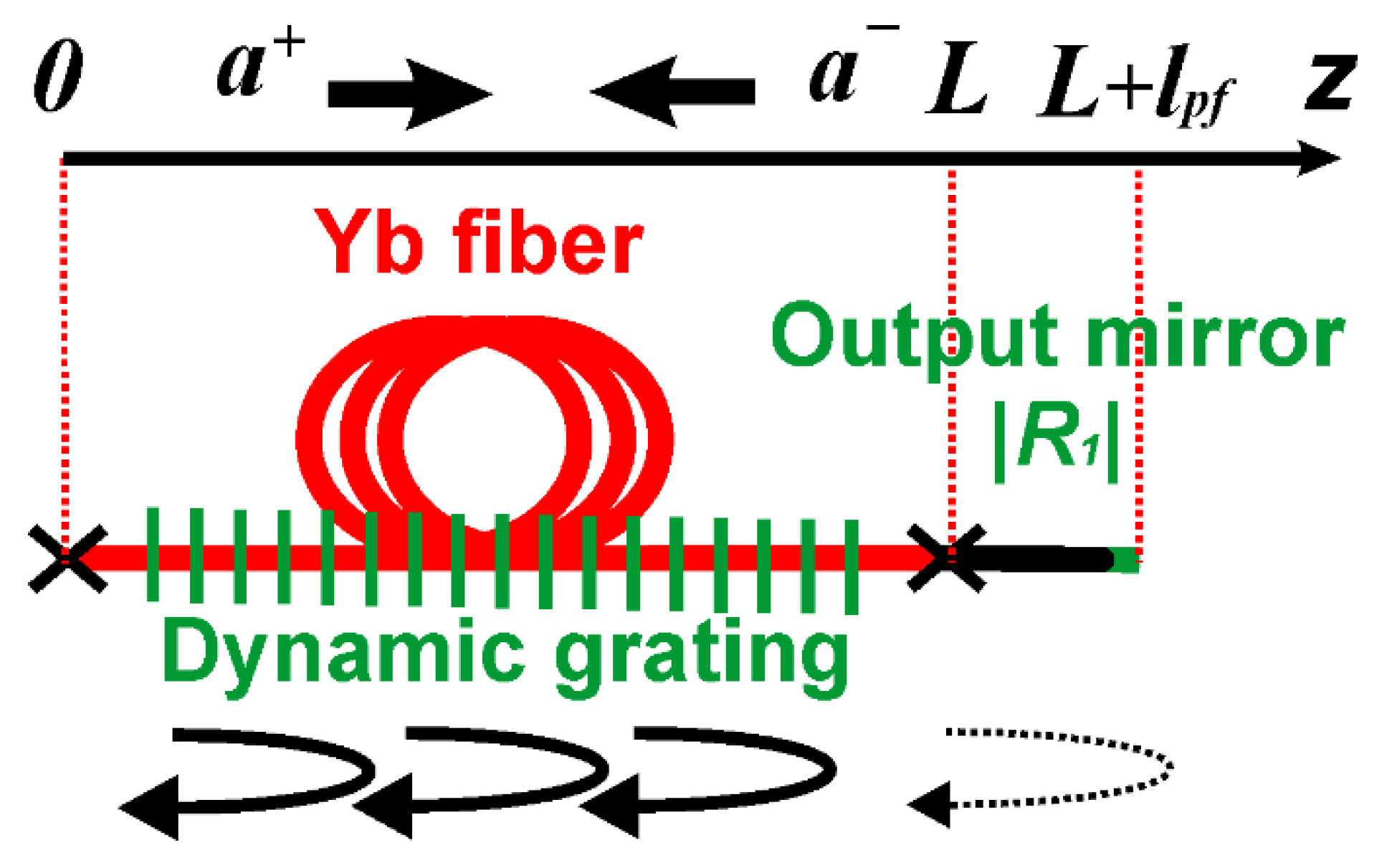
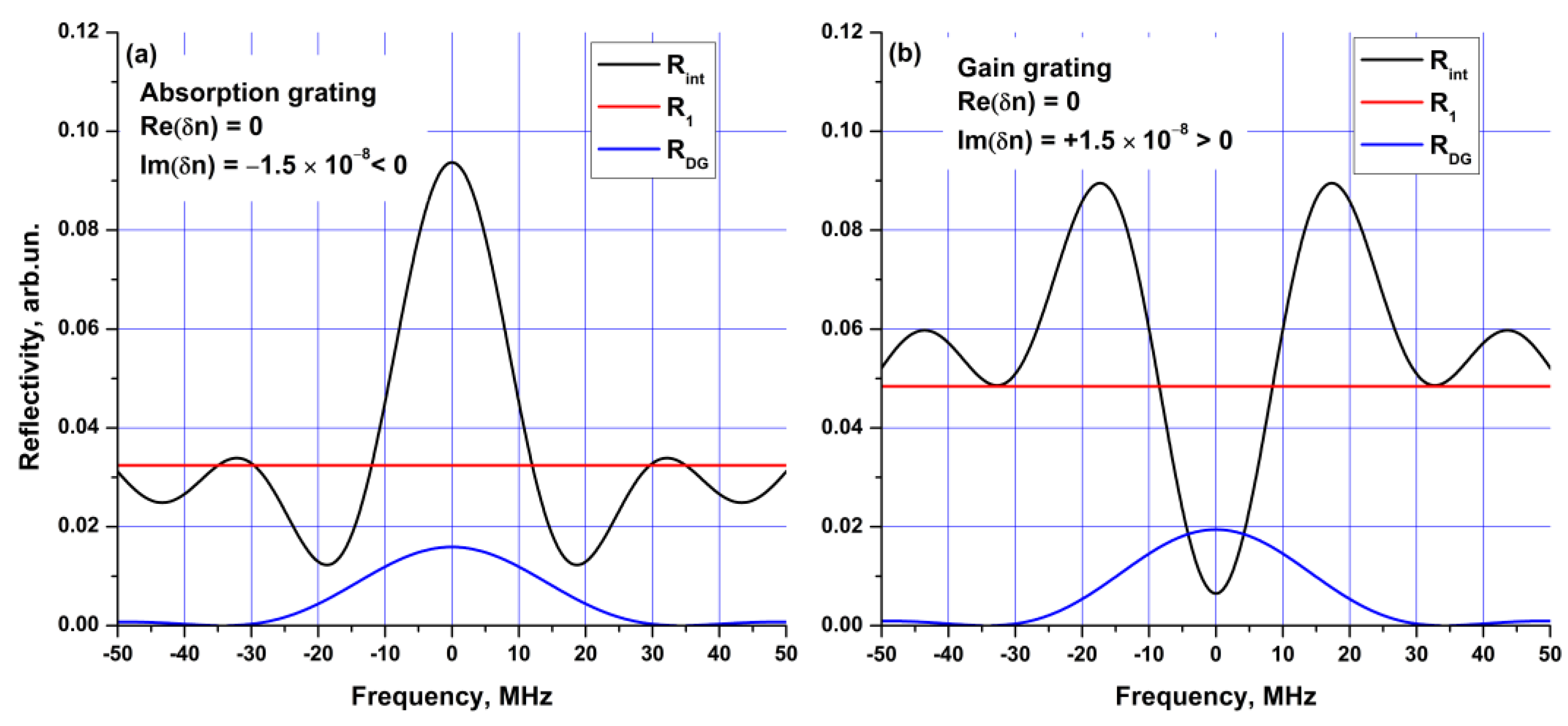
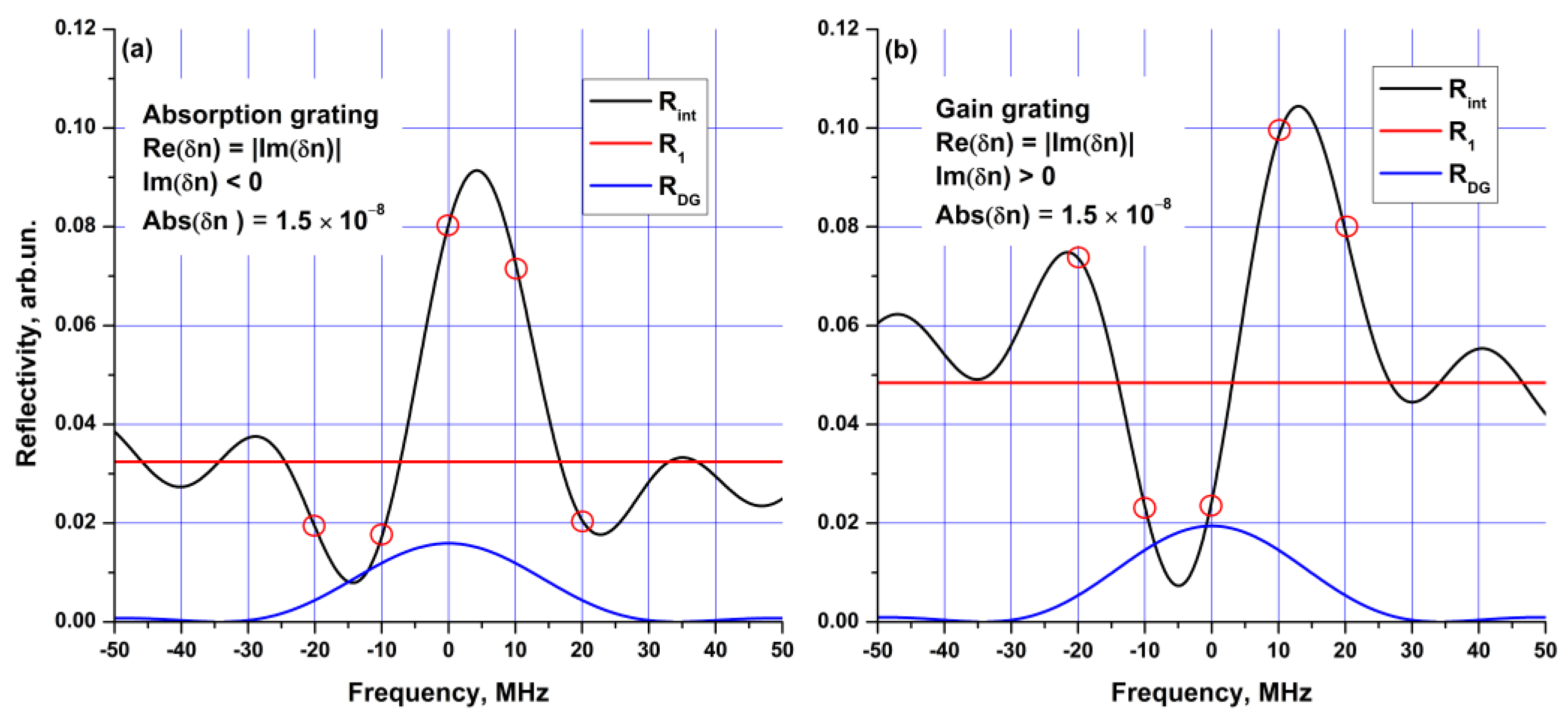
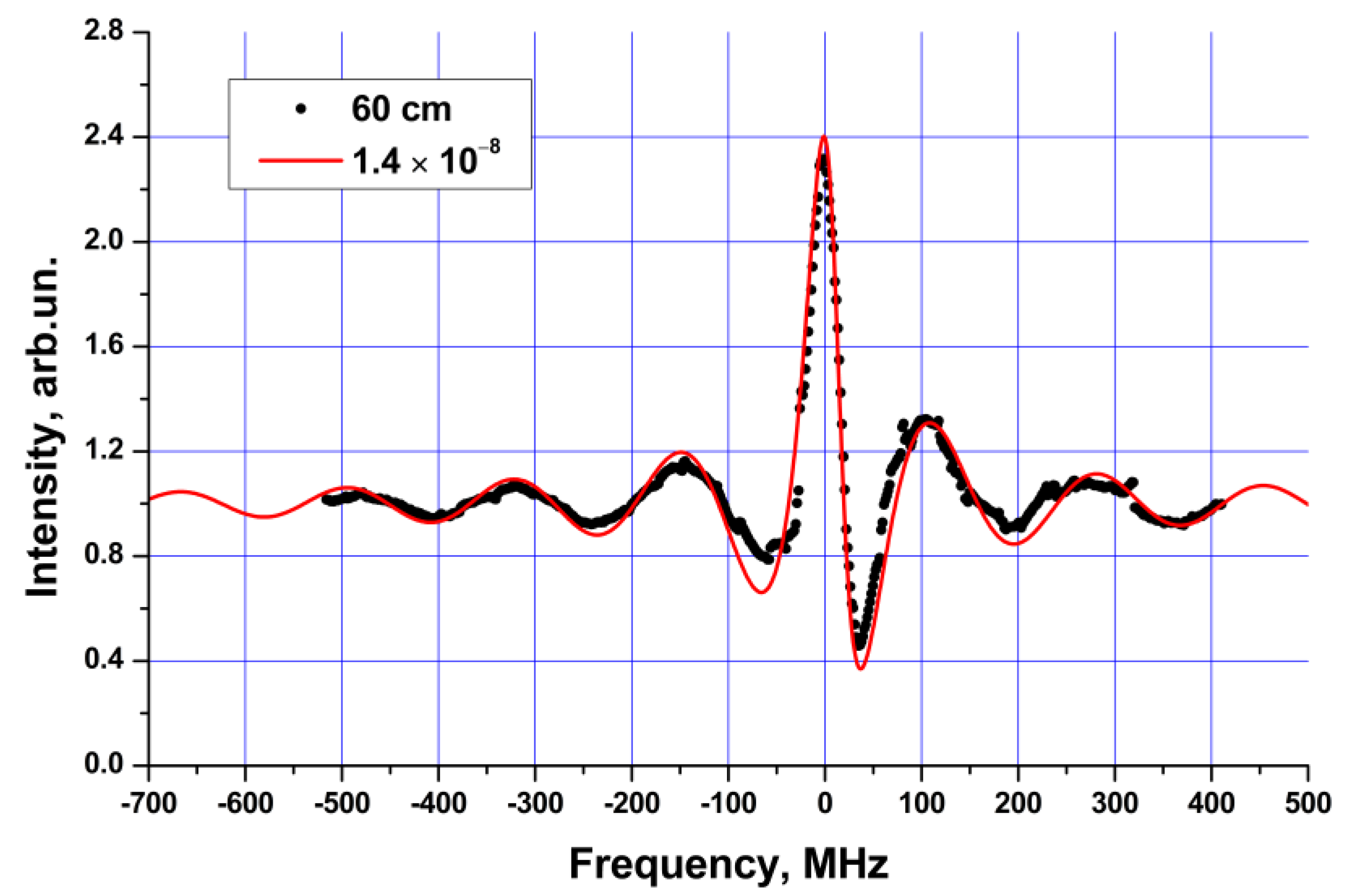
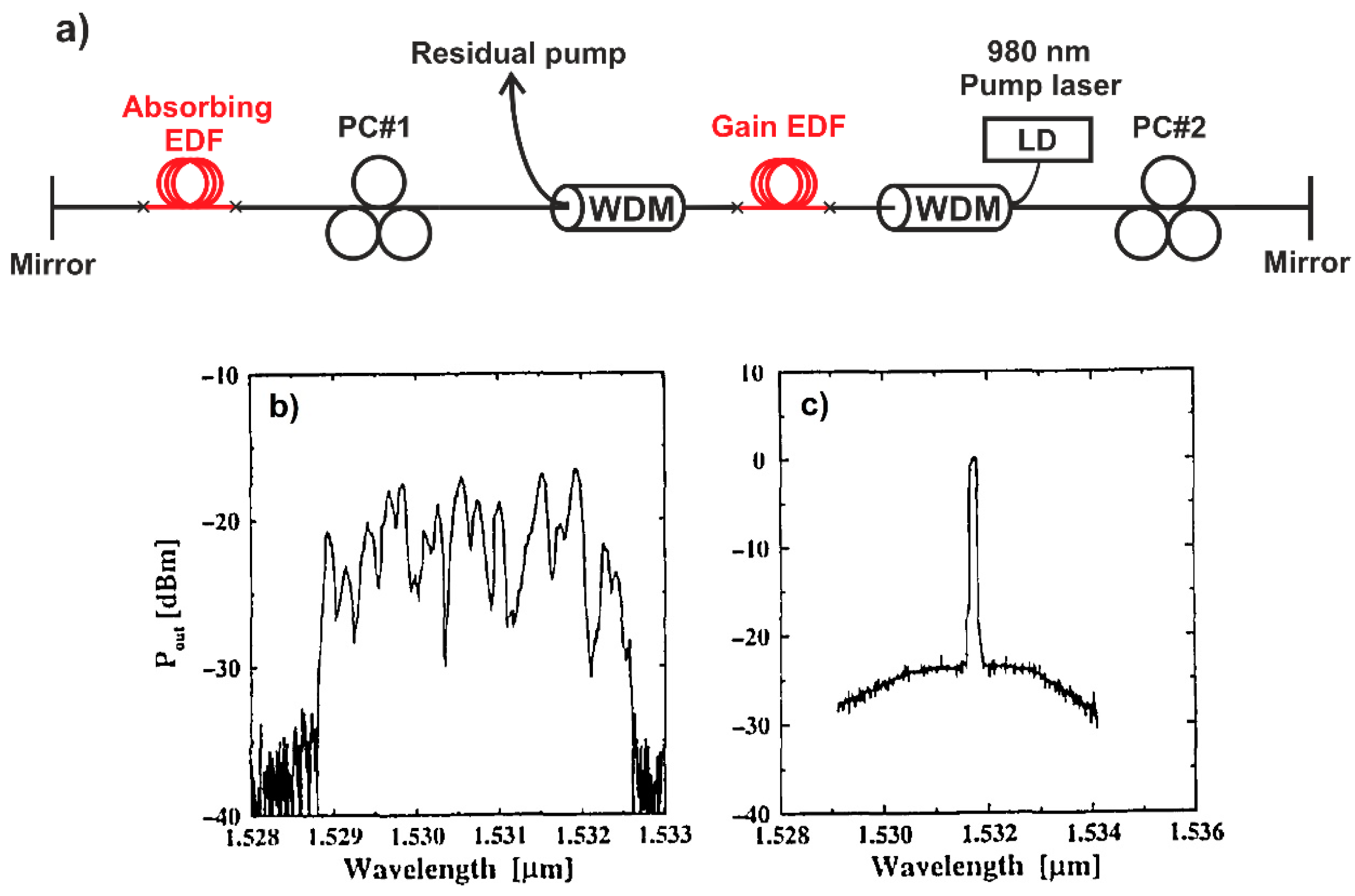
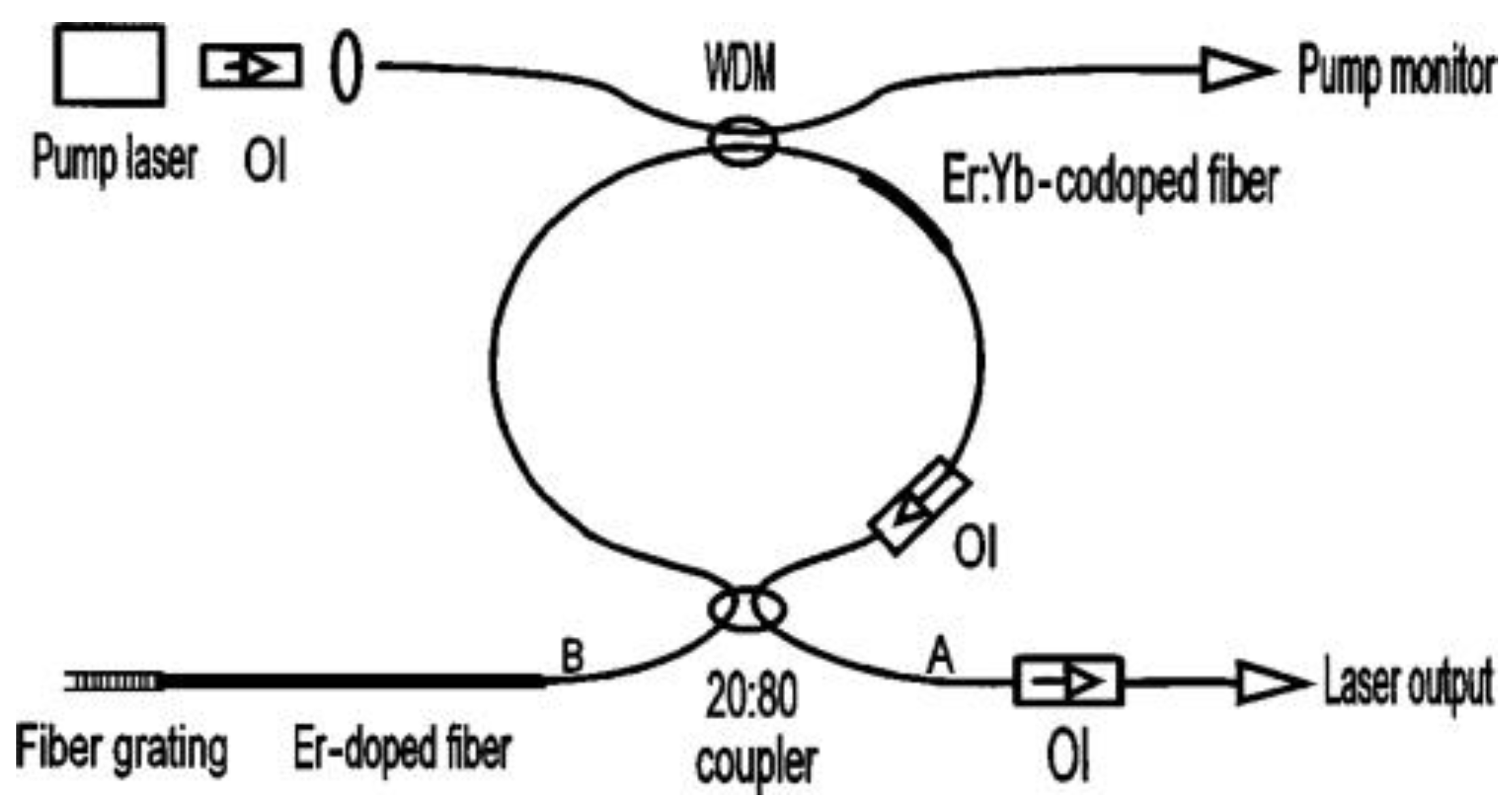

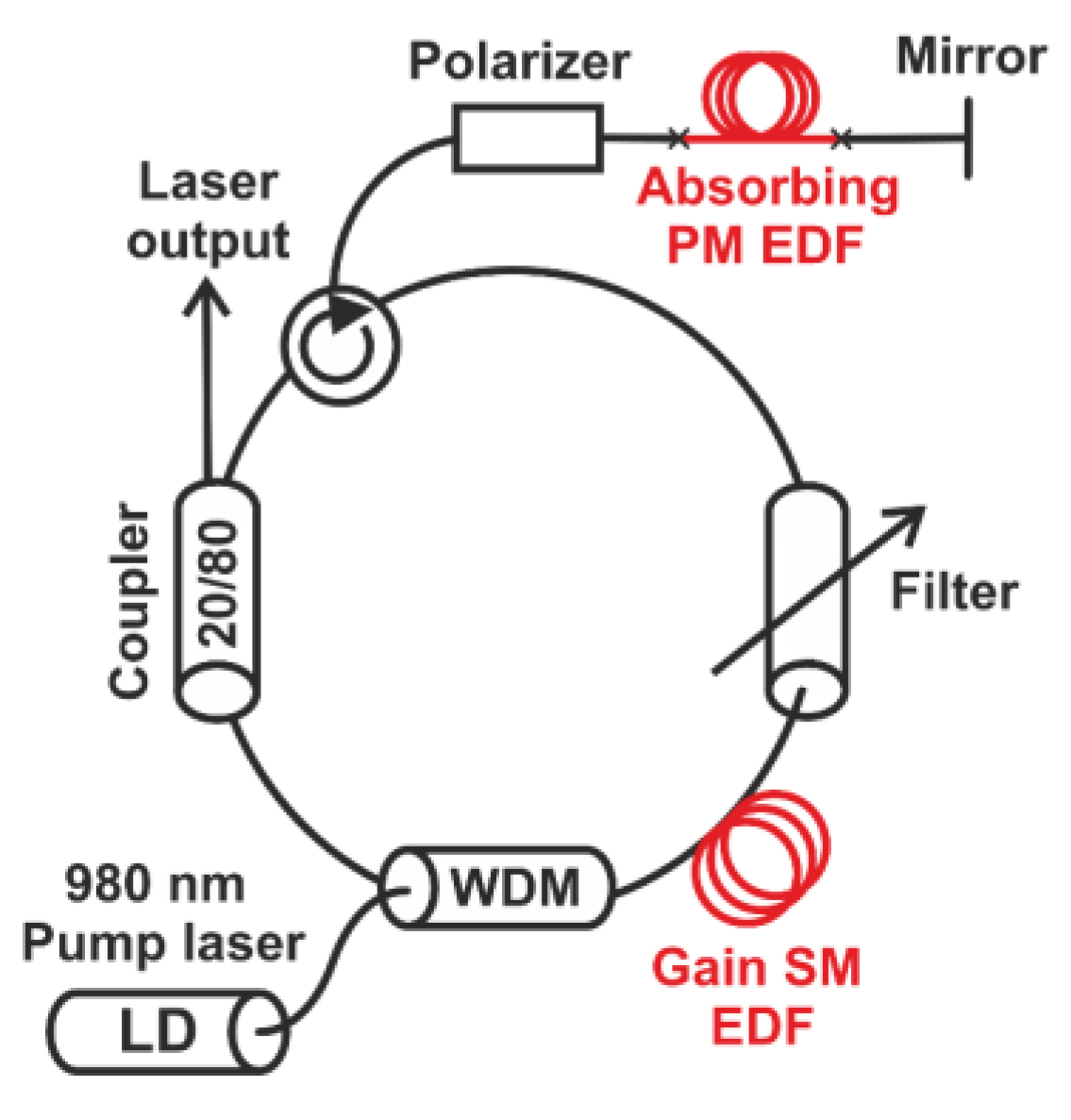
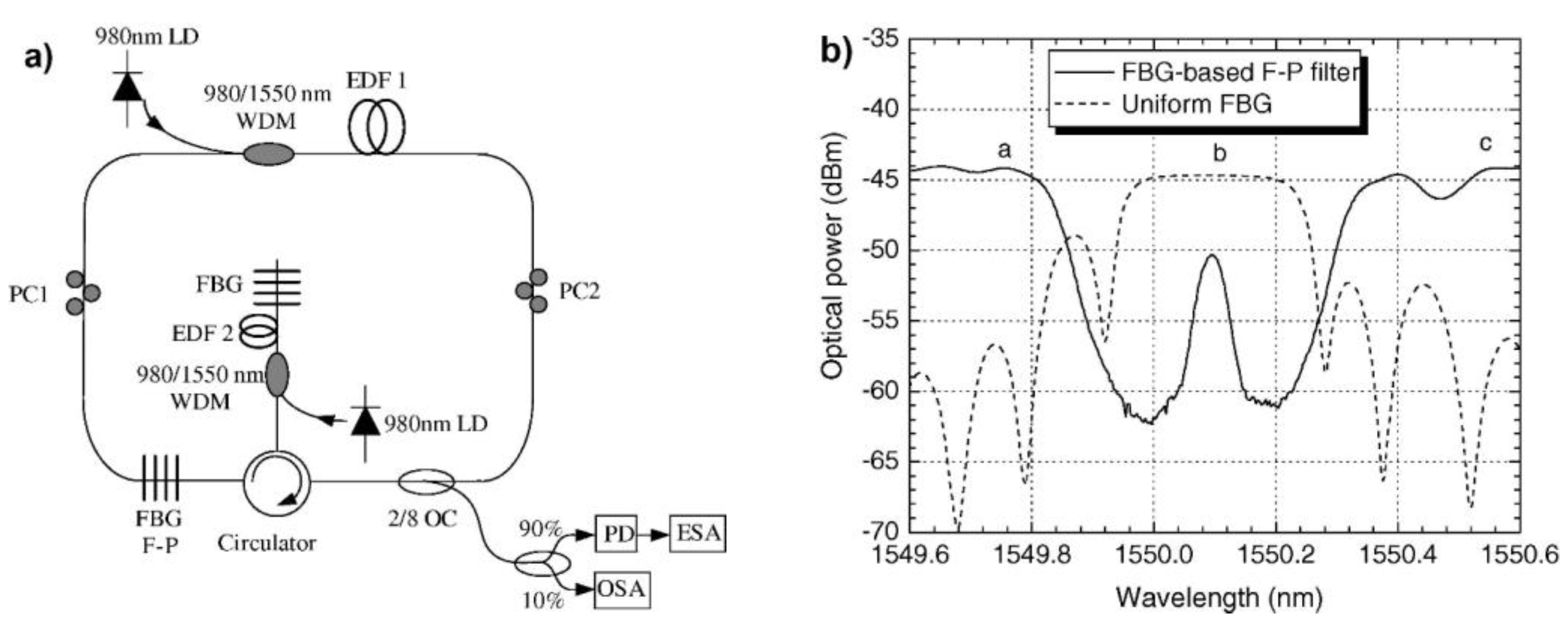
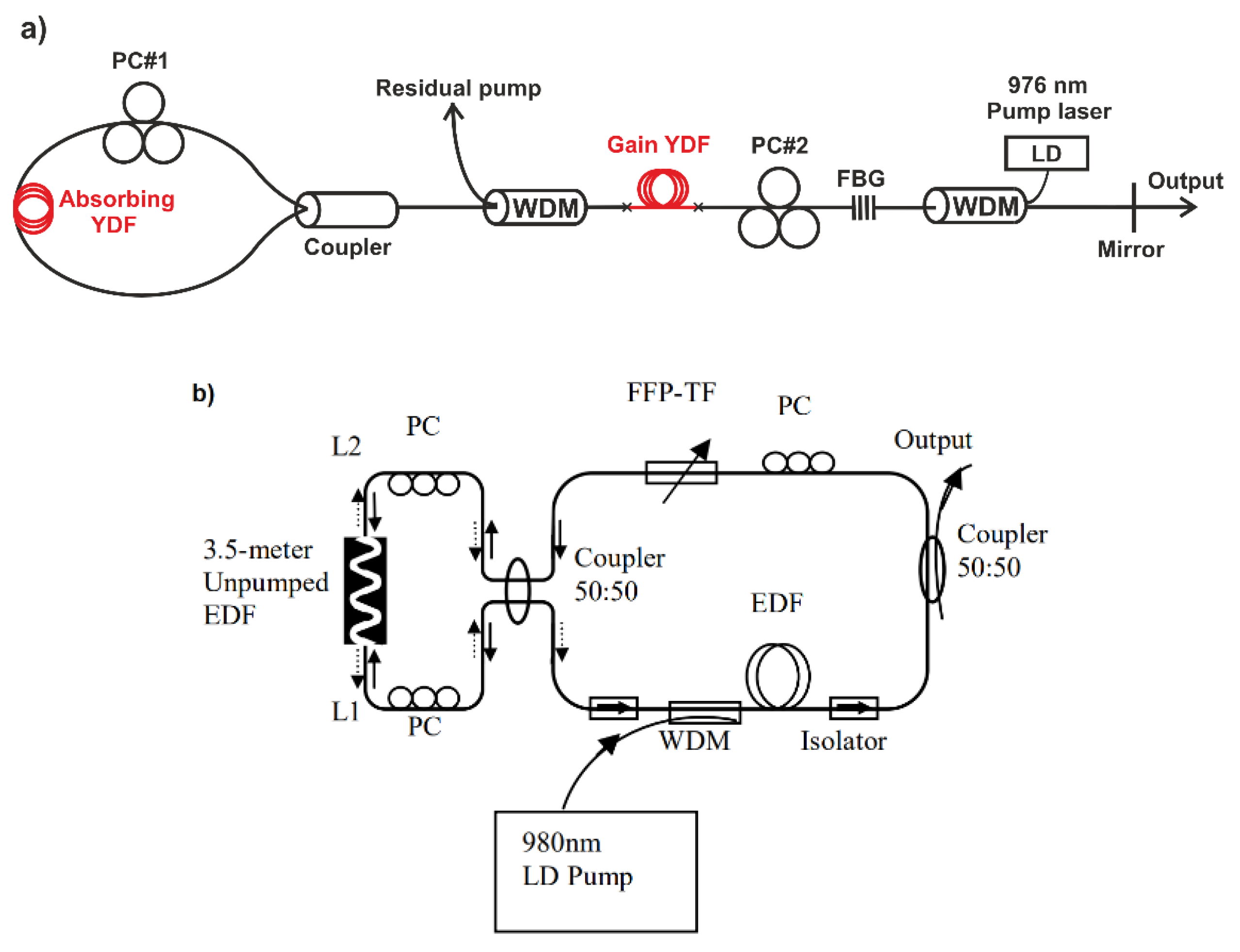


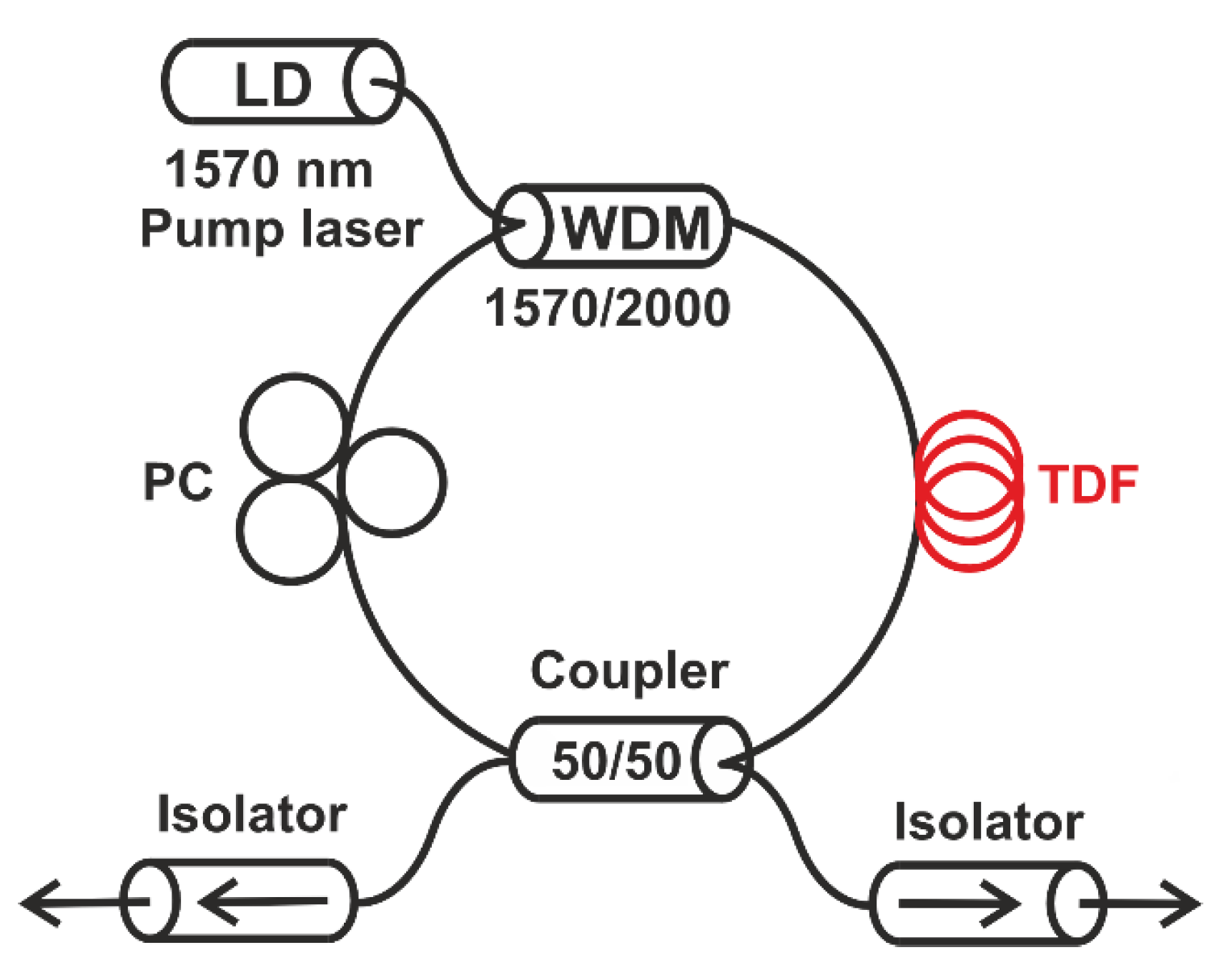


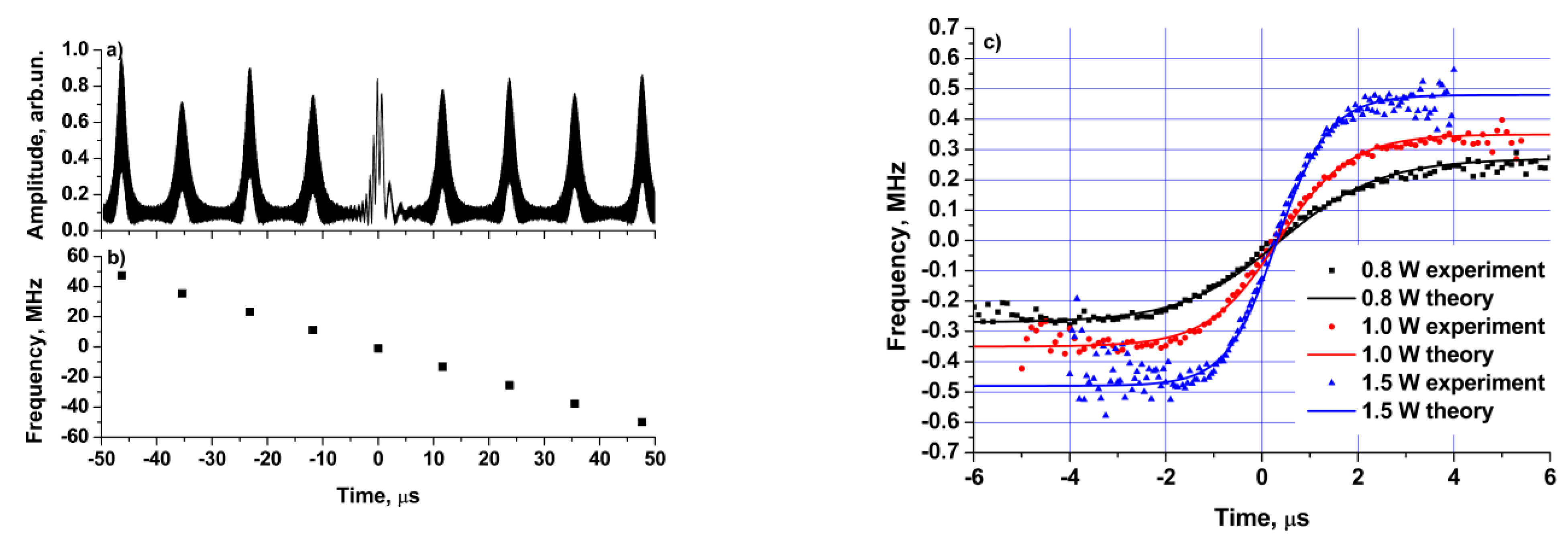
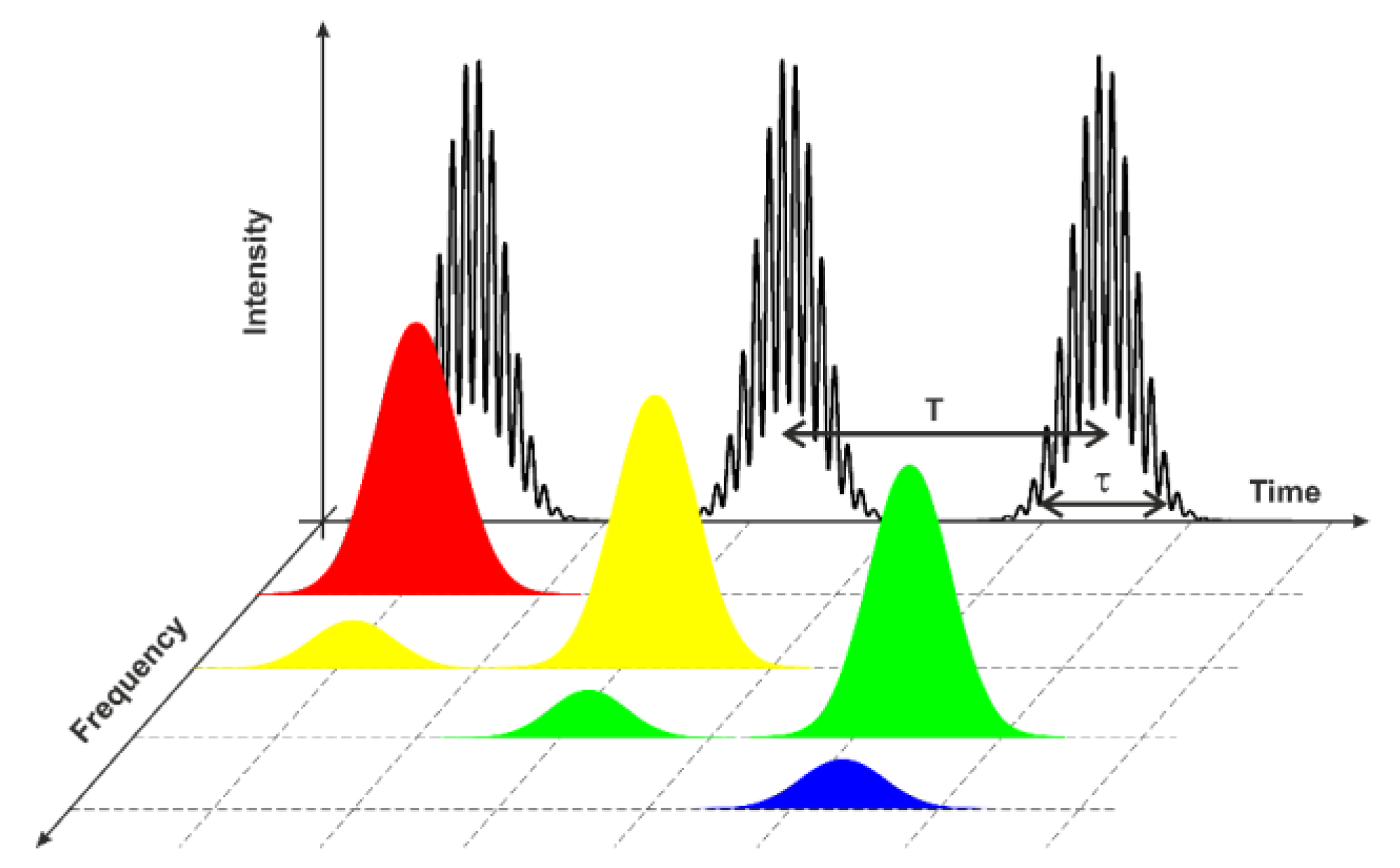
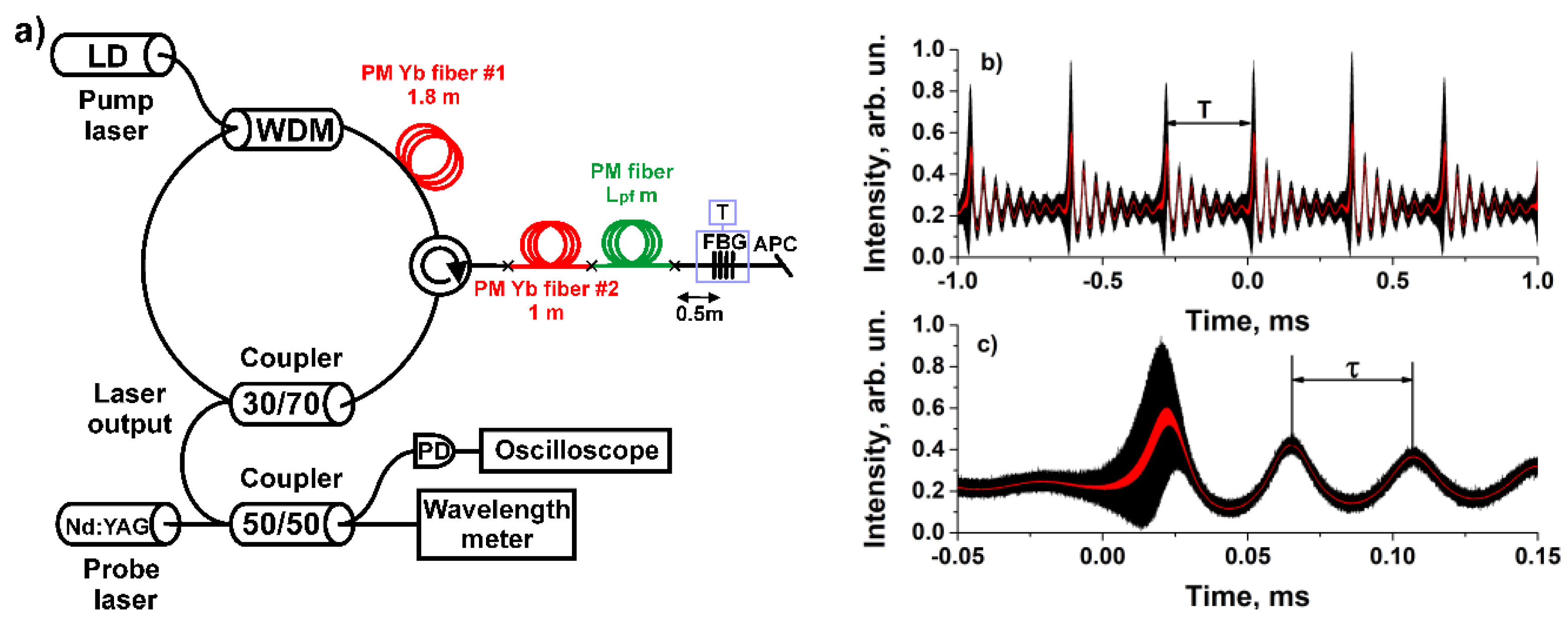

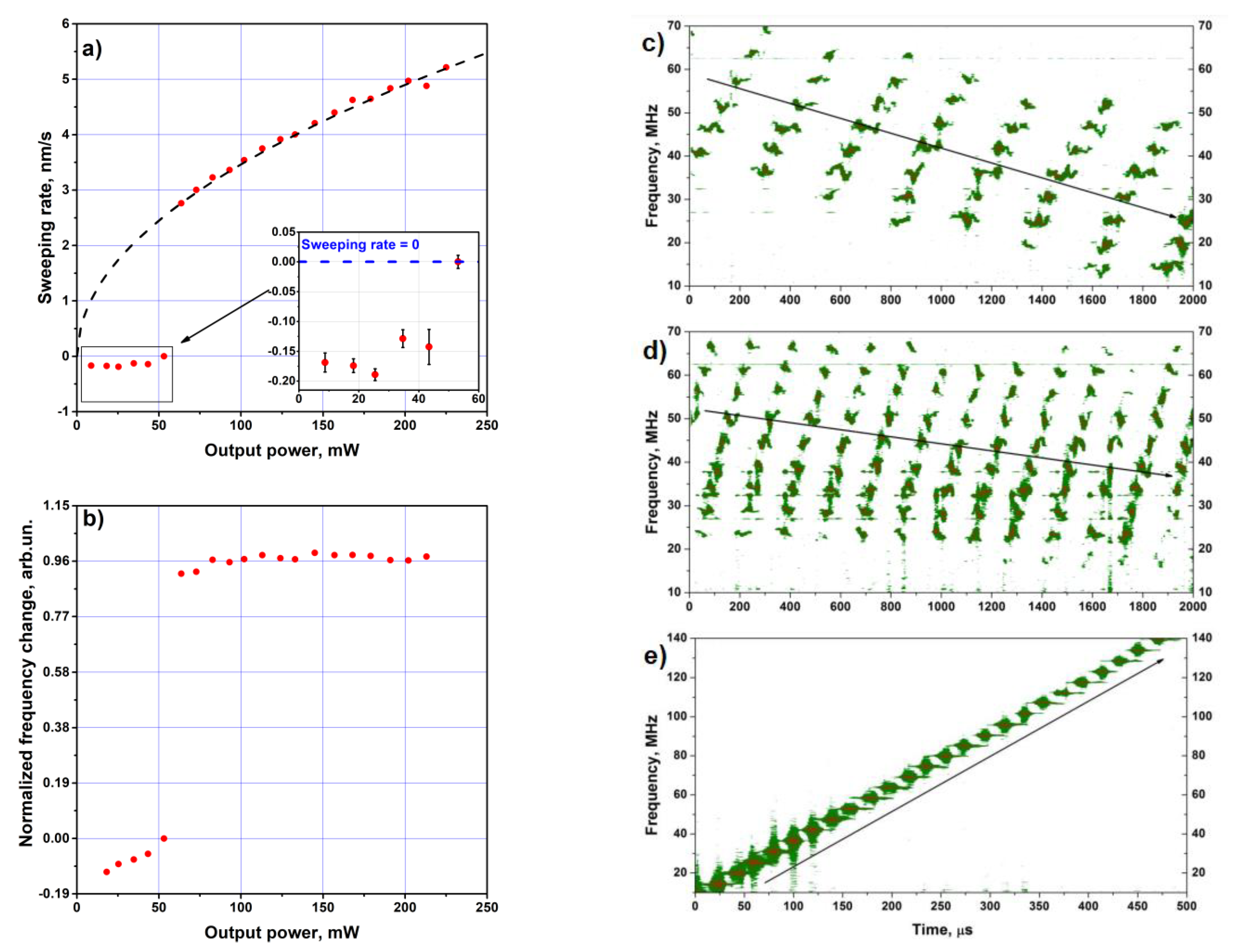

| Ref. | Scheme | Wavelength (nm)/ Linewidth (kHz) | Length and Absorption of SA | Power (mW)/ RIN (dB/Hz) | Comments |
|---|---|---|---|---|---|
| Erbium | |||||
| [59] [50] | Linear with PC | 1532/ <20 | 0.32 m, 2500 ppm | -/ - | Pioneer work |
| [60] | Sigma | 1550/ 0.95 | 0.2–6 m, 4.3 dB/m@ 1535 | 6.2/ −77 | Dependence on fiber length |
| [61] | Sigma | 1522–1562/ 0.75 | 4 m, - | 10/ - | Wavelength tuning |
| [68] | Sigma | 1550 | -, - | -/ - | Additional pump |
| [67] | Sigma | 1530–1570/ <1.5 | 0.5–5.5 m 5.27 dB/m @1535 | 4.7/ −74 | PM design of SA Dependence on fiber length Dependence on lasing wavelength |
| [71] | Ring | 1520–1570/ 0.7 | 3.5 m, - | 10/ - | Wavelength tuning SA in SM |
| [74] | Sigma | 1565/ - | 3 m, 240 ppm | 867/ - | Additional filtration |
| [76] | Sigma | 1550/ 0.5 | 3.6 m, 17.1 dB/m @1530 | -/ - | Fast phase control |
| [78] | Sigma | 1550/ - | 6 cm, 148 dB/m @ 1530 | -/ - | Very short SA |
| [75] | Sigma | 1550/ 1.09 | 3 m, - | 12.78/ - | Additional filtration |
| [63] | Sigma | 1552/ - | 2 m, Fibercore I25, 24.2 dB/m @ 979 Fibercore M12, 12.7 dB/m @ 979 | -/ - | Dependence on dopant concentration |
| Ytterbium | |||||
| [53] [54] | Linear with PC | 1064, 1083/ 2 | 1.2 and 5 m 24,000 ppm | 18/ - | SA in SM Dependence on fiber length Additional filtration |
| [73] | Sigma | 1053/ 10 | 2 m - | 10/ - | Additional filtration PM design of SA |
| [71] | Ring | 1020–1090/ | 1 m, Nufern SM-YSF-HI 250 dB/m @ 975 nm | 2.5/ 100 | Wavelength tuning SA in SM |
| [79] | Sigma | 1069/ 0.5 | 2 m, Nufern SM-YSF-HI | 7/ - | Very narrow linewidth |
| [77] | Sigma | 1064/ - | 2.5 m, Nufern SM-YSF-HI | -/ - | Dependence on pump wavelength |
| Thulium | |||||
| [72] [80] | Ring | 2004/ | 6.5 m | 8.4/ -/ | SA in SM |
| [81] | Sigma | 1957/ 20 | 2 m, Nufern, PM-TSF-9/125 | 61.6/ - | PM design of SA |
| [55] [56] | Sigma | 1720/ 4.4 | 0.75 m Nufern, SM-TSF-9/125 | 407/ - | Power bistability |
| [69] | Sigma | 1720/ 3.3 | 1.2 m Nufern SM-TSF-9/125 | 2560/ −112 | Additional pump Power bistability |
| Ref. | Scheme/ PM-SMF/ | Sweeping Range, nm/ Mode Composition | Gain Fiber | Comments |
|---|---|---|---|---|
| Ytterbium | ||||
| [84] | Ring SMF | @1050/ - | 3 m Liekki-Yb1200-6/125DC | The first observation of WLSS effect in fiber laser |
| [86] [87] | Linear (F + SM) SMF | 1062–1078/ Few-mode | 2.5 m Nufern SM-YDF-5/130 | The first unidirectional WLSS laser |
| [108] | Linear (F + F) SMF | 1081–1087/ - | 11.5 ± 0.5 m GTwave, 3.1 dB/m. | The first WLSS fiber laser |
| [85] [31] | Linear (F + F) & Ring SMF | 1077–1087 (Linear) 1086–1089 (Ring) Few-mode | 5 m Liekki-Yb1200-6/125DC | Parasitic feedback from connector |
| [100] | Linear (F + F) SMF | Up to 7 nm @ ~1079/ - | 4.85 m Liekki-Yb1200-6/125DC | WLSS control with power and wavelength of the pump |
| [92] | Linear (F + SM + Filter) SMF | 1087–1094/ SLM | 6.5 m CorActive DC-Yb-8/128 | The longest wavelength band for Yb Two polarization modes |
| [45] | Linear (F + SM) PM | 1058–1078/ SLM & Few-mode | 2.6 m Nufern PM-YDF-5/130 | The first mode analysis for WLSS laser |
| [93] | Linear (F + SM/Fiber mirror) PM | Up to 20 nm @ 1028–1080/ SLM & Few-mode | 0.3 to 4.3 m Nufern PM-YDF-5/130 | WLSS control with length and temperature of gain fiber WLSS control with output losses WLSS control with pump wavelength |
| [114] | Linear (F + F) SMF | 1076–1083 1079–1073/ Few-mode | 4.85 m Liekki Yb1200-6/125DC | WLSS control with pump power Reverse WLSS |
| [88] | Ring bidirectional SMF + PC | 1039–1036/ Few-mode | 1.5 m CorActive Yb501 | Reverse WLSS |
| [103] | Ring bidirectional PM | 1053–1060/ Few-mode | 1.5 m CorActive Yb401-PM | Reverse WLSS |
| [104] | Sigma SMF | 1066–1071/ SLM | 1.8 m CorActive Yb 501 | The fist CW WLSS for Yb WLSS in the scheme with SA |
| [42] | Sigma PM | 100 pm @1064 SLM | 1 m Nufern, PM-YDF-5/130 | Forward and reverse WLSS CW WLSS |
| [94] | Ring bidirectional PM | Up to 8.3 nm @1050/ Few-mode | 1.3 m Coractive Yb401-PM | WLSS control with incavity losses |
| Neodium | ||||
| [99] | Linear (F + SM + Filter) PM | 1.8 nm @1064/ SLM | 3 m Nufern PM-NDF-5/125 | The fist WLSS for Nd WLSS in doped fiber with 4-level |
| Bismuth | ||||
| [46] | Linear (F + FLM) PM | 1456–1466/SLM | 60 m PM Bi-fiber FORC | Non-RE-doping The smallest frequency hop ~1 MHz |
| Erbium | ||||
| [89] | Linear (F + SM + Filter) SMF | <0.1 nm @ 1550–1565/ Few-mode | 3.9 m EDF | The first Er-doped WLSS laser Additional filtration (FP filter and Tm-doped fiber) |
| [101] | Linear (F + SM) PM | 2.8 nm @1605/ Two-mode | 11 m IXF-EDF-HD-PM iXblue | The first CW WLSS The broadest WLSS range for Er |
| [110] | Sigma PM | 40 pm @1560 SLM | 2–18 m Coractive as ER 35–7-PM | CW WLSS |
| Thulium | ||||
| [102] | Linear (F + SM) SM | 1905–1922/ Few-mode | 4 m Tm-Ho fiber Coractive | The first Tm-doped WLSS laser |
| [104] | Ring bidirectional SM | 14 nm @1970 Few-mode | 2.5 m. TmDF200 OFS | Reverse WLSS The beating of polarization modes |
| [95] | Linear (F + SM) PM | 26 nm @1920 SLM | 5 m PM-TSF-9/125 Nufern | The broadest WLSS range for Tm CW to Pulse transition |
| [96] | Linear (F + SM) PM | 1915–1925 (normal) 1920–1910 (reverse) SLM & Few-mode | 5 m PM-TSF-9/125 Nufern | Normal to forward WLSS transition Wavelength stopping |
| [106] | Ring bidirectional SM | 1958–1945/ Few-mode | 2.5 m. TmDF200 OFS | Reverse WLSS The beating of polarization modes |
| Holmium | ||||
| [90] [91] | Linear (F + SM) SM | 4 nm @ 2100 3–5 nm @ 2100/ Few-mode | 5–8 m House-made HDF | The first WLSS for Ho Length and concentration optimization |
| [117] | Linear (F + SM) SM | 7 nm @ 2070/ Few-mode | 0.8, 3, 6 m House-made HDF | Length and concentration optimization |
| [97] [98] | Linear (F+SM) PM | 10 nm @ 2100/ Few-mode | 1.05 m IXF-HDF-PM-8-125 HD IXBlue | The broadest WLSS range for Ho CW to Pulse transition |
Publisher’s Note: MDPI stays neutral with regard to jurisdictional claims in published maps and institutional affiliations. |
© 2022 by the authors. Licensee MDPI, Basel, Switzerland. This article is an open access article distributed under the terms and conditions of the Creative Commons Attribution (CC BY) license (https://creativecommons.org/licenses/by/4.0/).
Share and Cite
Poddubrovskii, N.R.; Drobyshev, R.V.; Lobach, I.A.; Kablukov, S.I. Fiber Lasers Based on Dynamic Population Gratings in Rare-Earth-Doped Optical Fibers. Photonics 2022, 9, 613. https://doi.org/10.3390/photonics9090613
Poddubrovskii NR, Drobyshev RV, Lobach IA, Kablukov SI. Fiber Lasers Based on Dynamic Population Gratings in Rare-Earth-Doped Optical Fibers. Photonics. 2022; 9(9):613. https://doi.org/10.3390/photonics9090613
Chicago/Turabian StylePoddubrovskii, Nikita R., Roman V. Drobyshev, Ivan A. Lobach, and Sergey I. Kablukov. 2022. "Fiber Lasers Based on Dynamic Population Gratings in Rare-Earth-Doped Optical Fibers" Photonics 9, no. 9: 613. https://doi.org/10.3390/photonics9090613
APA StylePoddubrovskii, N. R., Drobyshev, R. V., Lobach, I. A., & Kablukov, S. I. (2022). Fiber Lasers Based on Dynamic Population Gratings in Rare-Earth-Doped Optical Fibers. Photonics, 9(9), 613. https://doi.org/10.3390/photonics9090613







